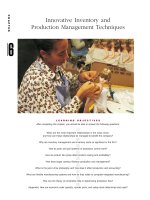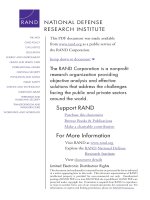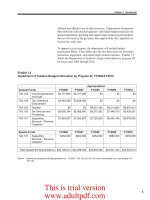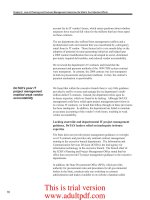Lecture Principle of inventory and material management - Lecture 24
Bạn đang xem bản rút gọn của tài liệu. Xem và tải ngay bản đầy đủ của tài liệu tại đây (460.87 KB, 31 trang )
Lecture 24
Order Quantities (Continued)
Books
•
Introduction to Materials Management, Sixth Edition, J. R. Tony Arnold, P.E., CFPIM, CIRM, Fleming
College, Emeritus, Stephen N. Chapman, Ph.D., CFPIM, North Carolina State University, Lloyd M.
Clive, P.E., CFPIM, Fleming College
•
Operations Management for Competitive Advantage, 11th Edition, by Chase, Jacobs, and Aquilano, 2005,
N.Y.: McGrawHill/Irwin.
•
Operations Management, 11/E, Jay Heizer, Texas Lutheran University, Barry Render, Graduate School of
Business, Rollins College, Prentice Hall
Objectives
•
•
•
•
•
•
Probabilistic Models and Safety Stock
Probabilistic Demand
Other probabilistic models
Fixed period system
EOQ consequences
Period order quantity model
Probabilistic Models and Safety Stock
Used when demand is not constant or
certain
þ
Use safety stock to achieve a desired
service level and avoid stockouts
þ
ROP = d x L + ss
Annual stockout costs = the sum of the units short x the probability x the stockout
cost/unit
x the number of orders per year
Safety Stock Example
ROP = 50 units
Orders per year = 6
Stockout cost = $40 per frame
Carrying cost = $5 per frame per year
Number of Units
ROP
30
40
50
60
70
Probability
.2
.2
.3
.2
.1
1.0
Safety Stock Example
ROP = 50 units
Orders per year = 6
Stockout cost = $40 per frame
Carrying cost = $5 per frame per year
Safety
Stock
Additional
Holding Cost
20
(20)($5) = $100
10
(10)($5) = $ 50 (10)(.1)($40)(6)
0
$
Total
Cost
Stockout Cost
$0
$100
= $240
$290
0 (10)(.2)($40)(6) + (20)(.1)($40)(6) = $960
$960
A safety stock of 20 frames gives the lowest total cost
ROP = 50 + 20 = 70 frames
Probabilistic Demand
Inventory level
Minimum demand during lead time
Maximum demand during lead time
Mean demand during lead time
ROP = 350 + safety stock of 16.5 = 366.5
ROP
Normal distribution probability of
demand during lead time
Expected demand during lead time (350 kits)
Safety stock
0
Lead
time
Place
order
Receive
order
16.5 units
Time
Probabilistic Demand
Risk of a stockout
(5% of area of
normal curve)
Probability of
no stockout
95% of the time
Mean
demand
350
0
ROP = ? kits
Quantity
Safety
stock
z
Number of
standard deviations
Probabilistic Demand
Use prescribed service levels to set safety stock
when the cost of stockouts cannot be determined
ROP = demand during lead time + ZσdLT
where
Z = number of standard
deviations
σdLT = standard deviation
of demand during lead time
Probabilistic Example
Average demand = µ = 350 kits
Standard deviation of demand during lead time = σdLT = 10 kits
5% stockout policy (service level = 95%)
Using Appendix I, for an area under the curve of 95%, the Z = 1.65
Safety stock = ZσdLT = 1.65(10) = 16.5 kits
Reorder point
= expected demand
during lead time + safety stock
= 350 kits + 16.5 kits
of safety stock
= 366.5 or 367 kits
Other Probabilistic Models
When data on demand during lead time is not
available, there are other models available
When demand is variable and lead time
is constant
2. When lead time is variable and demand
is constant
3. When both demand and lead time are
variable
1.
Other Probabilistic Models
Demand is variable and lead time is constant
ROP =
where
(average daily demand
x lead time in days) + ZσdLT
σd = standard deviation of demand per day
σdLT = σd
lead time
Probabilistic Example
Average daily demand (normally distributed) = 15
Standard deviation = 5
Lead time is constant at 2 days
90% service level desired
Z for 90% = 1.28
From Appendix I
ROP = (15 units x 2 days) + Zσdlt
= 30 + 1.28(5)( 2)
= 30 + 9.02 = 39.02 ≈ 39
Safety stock is about 9 iPods
Other Probabilistic Models
Lead time is variable and demand is constant
ROP = (daily demand x
average lead time in days)
= Z x (daily demand) x
σLT
where
σLT = standard deviation of lead time in days
Probabilistic Example
Daily demand (constant) = 10
Average lead time = 6 days
Standard deviation of lead time = σLT = 3
98% service level desired
Z for 98% = 2.055
From Appendix I
ROP = (10 units x 6 days) + 2.055(10 units)(3)
= 60 + 61.65 = 121.65
Reorder point is about 122 cameras
Other Probabilistic Models
Both demand and lead time are variable
ROP =
(average daily demand
x average lead time) + ZσdLT
σd = standard deviation of demand per day
σLT = standard deviation of lead time in days
σdLT =
(average lead time x σd2)
+ (average daily demand)2 x σLT2
Probabilistic Example
Average daily demand (normally distributed) = 150
Standard deviation = σd = 16
Average lead time 5 days (normally distributed)
Standard deviation = σLT = 1 day
95% service level desired
Z for 95% = 1.65
From Appendix I
ROP = (150 packs x 5 days) + 1.65σdLT
= (150 x 5) + 1.65 (5 days x 162) + (1502 x
12)
= 750 + 1.65(154) = 1,004 packs
FixedPeriod (P) Systems
Orders placed at the end of a fixed period
þ
Inventory counted only at end of period
þ
Order brings inventory up to target level
þ
Only relevant costs are ordering and holding
þ
Lead times are known and constant
þ
Items are independent from one another
þ
FixedPeriod (P) Systems
Target quantity (T)
Q4
On-hand inventory
Q2
Q1
Q3
P
P
Time
P
FixedPeriod (P) Example
3 jackets are back ordered
It is time to place an order
No jackets are in stock
Target value = 50
Order amount (Q) = Target (T) - On-hand
inventory - Earlier orders not yet received
+ Back orders
Q = 50 - 0 - 0 + 3 = 53 jackets
FixedPeriod Systems
Inventory is only counted at each review
period
þ
May be scheduled at convenient times
þ
Appropriate in routine situations
þ
May result in stockouts between periods
þ
May require increased safety stock
þ
EOQ Assumptions
•
•
•
•
Demand is relatively constant and is known.
The item is produced or purchased in lots or batches
and not continuously.
Order prep costs & inventorycarrying costs are
constant and known.
Replacement occurs all at once.
EOQ Consequences
Average inventory = EOQ lot size / 2
# of orders per year
= Annual demand / lot size
Basic EOQ Model
•
•
•
•
Demand is constant over time
Inventory drops at a uniform rate over time
When the inventory reaches 0, the new order is placed and
received, and the inventory level again jumps to Q units
The optimal order quantity will occur at a point where the
total setup cost is equal to the total holding cost
Basic EOQ:
2AS
2ADS
Q* =
=
ic
i
Basic EOQ Model (cont.)
•
Benefit of EOQ model:
–
•
It is a robust model, meaning that it gives
satisfactory answers even with substantial variation
in the parameters.
Reorder Points:
–
–
Lead Time the time between the placement and
receipt of an order.
The whentoorder decision is expressed in terms of
a reorder point, the inventory level at which an order
should be placed.
Inventory Level Over Time
(Basic EOQ Model)
Inventory Level
Maximum Inventory Level
Average
Inventory Level
Time









